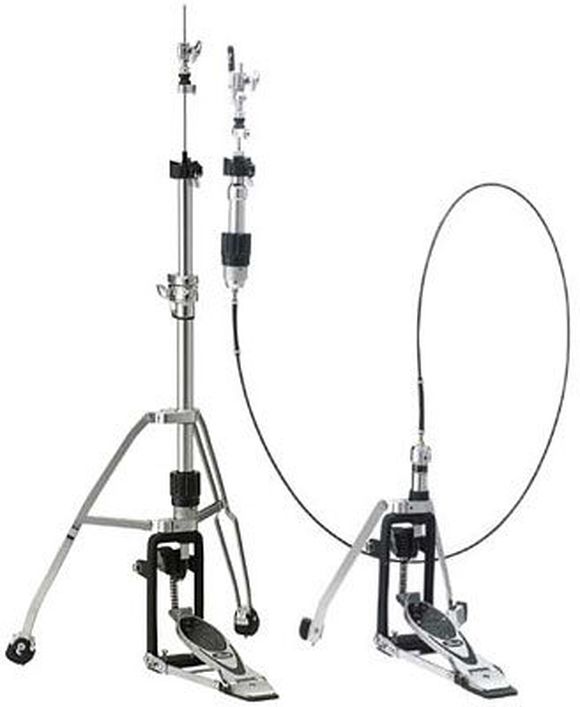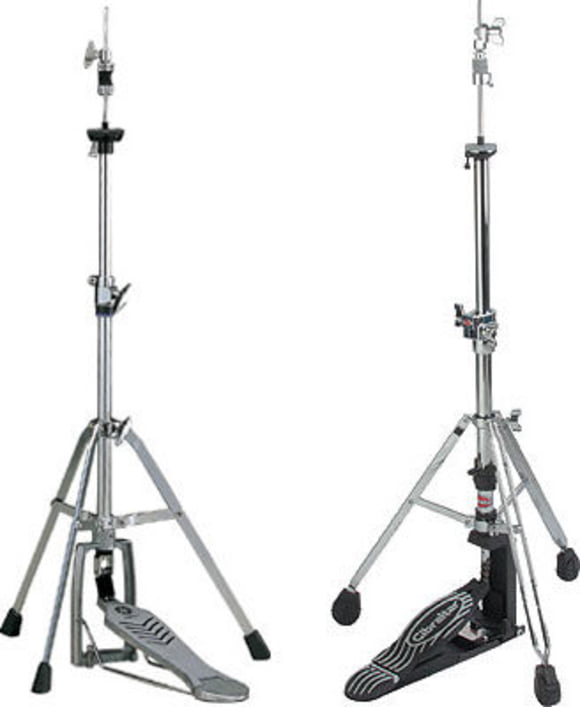3. Hi Hats
The hi hat stand operates the hi hats not so exciting, or is it? The Job of any hi hat stand is to control the up and down movement of the hi hats. The aim is a clean opening, an easy closing and a comfortable operation of the pedal. Just like the kick pedal, the hi hat stand should make as little noise as possible. That is of great importance when recording be it at home or in a studio. Of course the stand has to be of solid build and has to be adjustable. To ensure stable positioning the regular hi hat stand has three legs. You get them in single or double brace models. Usually double brace is better but with hi hat stands there is an exception. More later.
One of the most important criteria is the adjustability of the spring tension lifting the pedal. It makes sure that the top hat remains lifted from the bottom hat in basic position, moves smoothly onto the bottom hat when operating the pedal and returns into starting position again when lifting the foot. To allow for different hi hats you get different sizes (12,13,14) as well as heavy and light ones the spring tension can be adjusted.
The seat of the bottom hat is also important. The felt ring should not be too small the bottom hat rests more comfortably on a big one. The gradient of the bottom head has to be adjustable. A screw in the bottom seat takes care of that, raising or lowering one side of the hat.
The result is top and bottom hat closing precisely on each other delivering the desired sound. On a good hi hat stand this can be done very precisely.
Back to the legs. If you play a single kick pedal you should choose a double braced hi hat stand especially when playing larger hats. Double braced hardware is simply more stable, the center of gravity is lower and it does not tip easily.
If you employ a double pedal things are a bit different. The auxiliary pedal is placed just beside the hi hat pedal depending on hi hat stand we might have a problem now. The forward, inner leg is positioned just above the auxiliary kick pedal (unless your name is Steward Copeland and you have it placed to the outside). With many single stands this works just about. With double brace stands you are on a narrow margin. The best solution would be to raise the legs (Keep the stand folded up) and fix the stand with a truss on the bass drum. Having braced the double pedal to the hi hat with a multi clamp they both stand bomb proof now and you have enough leg space.
For use with a double kick pedal you can get hi hat stands with just 2 legs pointing to the back. In the front you have space for the extra pedal.

Alternatively you could use a cable hi hat.
If you are playing a big set this makes good sense. The connection between pedal and hats is not a bar, but a cable a bit like the brakes on a bike. The advantage is that you can position the hats just about anywhere on your set. The hats can even be tilted. Of course you need something to hold it in place, but a multi clamp goes a long way. The pedal can also be placed just where you want it no hardware is in your way.
Cable hi hats are particularly popular with multi pedal players. You can easily integrate a second hi hat into the set, mostly just right of the kick drum. The second hi hat ( mostly smaller size) not only offers you a greater sound variety, but you can play open handed the right hand does not cross the left one.




